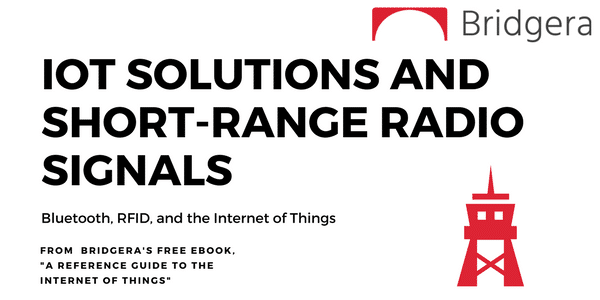Short Range IoT Radio Solutions
Unlike Long and Medium range radio solutions, we define short range as solutions with signal range ≤30m. The most common technologies in use include Bluetooth (or its evolution Bluetooth LE) and RFID. These options are some of the most versatile choices for your IoT solution.
Bluetooth and IoT Solutions
Bluetooth has become common in computing and consumer product markets, and is one of the most popular standards for IoT solutions. The Bluetooth standard is generally intended as a “cable replacement” technology. It is used for transferring medium amounts of data over a relatively short distance (30m). Bluetooth is widely accepted in audio applications, such as cell phone headsets and wireless speakers.
Adapted from the Bluetooth standard, Bluetooth Low-Energy (BLE) (marketed as Bluetooth Smart) is the new hot topic. It will be key for wearable products, likely through connection to a smartphone. Different from the original Bluetooth, BLE sends small amounts of data, requiring very little energy. Surprisingly, it is not backwards-compatible with the original Bluetooth standard.
BLE’s range is similar to the traditional Bluetooth’s range. However, it offers improvements in latency, power consumption, and data robustness. These improvements come at the cost of reduced effective data rates, maxing out at several hundred kbps. Despite this, BLE has the potential to support many IoT applications.
Bluetooth is already integrated into smartphones and many other personal, mobile devices. This is a major advantage Bluetooth has over many competing technologies. By 2018, most Bluetooth-enabled smartphones (iOS, Android, and Windows based models), should be ‘Smart Ready.’
Devices that employ Bluetooth Smart features incorporate the Bluetooth Core Specification Version 4.0 (or higher) with a combined low-data-rate and low-energy core configuration. Version 4.2’s Internet Protocol Support Profile allows Bluetooth Smart sensors to access the Internet directly via 6LoWPAN connectivity. This IP connectivity makes it possible to use existing IP infrastructure to manage Bluetooth Smart ‘edge’ devices.
Other enhancements will also enable enterprises to use Bluetooth beacons for indoor location applications. BLE has a mechanism allowing devices to broadcast information about identity and capability. This enables coordination between devices. Google’s Physical Web concept uses BLE beacons. BLE allows the broadcasting of rich data, like location information, URLs, and multimedia files.
Lacking a mesh network protocol and having a short range are two limitations for Bluetooth. In fact, not having a mesh network is one factor keeping Bluetooth out of larger distributed sensor networks. Although a mesh solution is in development, it is significantly behind others.
Bluetooth Key Features:
- Covers all the layers of the primary reference model. The Bluetooth SIG defines the radio interface, software stack, and specifications for how a device works in an
- Operates in the unlicensed 2.4 GHz
- Uses frequency hopping spread spectrum (HPSS) to improve communications in noisy channels and to avoid BLE adds robustness through use of CRC and a Message Integrity Check (MIC).
- Allows for three different types of radio powers: Class 1 = 100mW (20 dBm), Class 2 = 2.5mW (4 dBm), and Class 3 = 1mW (0 dBm).
- The max output power for BLE is 10mW (10dBm).
- Range is <30m (Smart/BLE)
- Data Rates: up to 2 Mbps (Bluetooth), 270kbps (BLE). Note BLE is mainly intended to be a very low data rate solution (e.g. transfer state knowledge or simple telemetry)
- Provides security through 128 bit AES
- Both Bluetooth and BLE have a defined certification process through the Bluetooth SIG
Bluetooth version 5 will include one-to-many messaging capabilities. It will also offer greater range, speed, and interoperability.
RFID
*Radio-frequency identification (RFID) uses electromagnetic fields to automatically identify and track tags attached to objects. The tags contain electronically stored information. Passive tags collect energy from a nearby RFID reader’s interrogating radio waves. Active tags have a local power source (such as a battery) and may operate hundreds of meters from the RFID reader. Unlike a barcode, the tag need not be within the line of sight of the reader, so it may be embedded in the tracked object. RFID is a method for Automatic Identification and Data Capture (AIDC).
RFID tags are used in many industries, for example, an RFID tag attached to an automobile during production can be used to track its progress through the assembly line; RFID-tagged pharmaceuticals can be tracked through warehouses; and implanting RFID microchips in livestock and pets allows for positive identification of animals.
Since RFID tags can be attached to cash, clothing, and possessions, or implanted in animals and people, the possibility of reading personally-linked information without consent has raised serious privacy concerns.[2] These concerns resulted in standard specifications development addressing privacy and security issues. ISO/IEC 18000 and ISO/IEC 29167 use on-chip cryptography methods for untraceability, tag and reader authentication, and over-the-air privacy. ISO/IEC 20248 specifies a digital signature data structure for RFID and barcodes providing data, source and read method authenticity. This work is done within ISO/IEC JTC 1/SC 31 Automatic identification and data capture techniques. Tags can also be used in shops to expedite checkout, and to prevent theft by customers and employees.
Short range radio signal solutions are some of the most popular technologies for IoT systems. They offer both stability and accessibility, and have been adopted internationally by developers.
*Wikipedia description of RFID
About the Author: This is an excerpt from our eBook co-authored by Bridgera LLC and RIoT.
Bridgera LLC is a Raleigh, NC based software company specializing in IoT software solutions with Bridgera IoT, not just another IoT Platform but Custom Software-as-a-Service for the Internet of Things.
RIoT is a registered trademark of the Wireless Research Center of North Carolina. RIoT represents a network of technologists, engineers, business leaders, academics, policy makers, and entrepreneurs, all of whom have a stake in the Internet of Things industry.
Search Our Blog
Most Recent
- Is Your Business Ready for AI? Find Out with the AI Readiness Assessment
- Bridgera Recognized as a Top AI, Logistics, and Software Development Company in 2025
- Predictive Maintenance in Manufacturing: How AI Is Transforming Uptime, Costs & Safety
- 5 Ways AI Can Address Logistics Challenges
- Industrial Revolution 4.0: IoT vs IIoT

